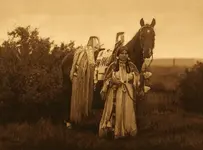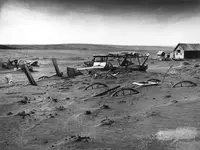The 3/12/1915 article had her son recover a can she gave direction to. Then mentions the earlier (19 years) can cache.
Plowing means turning somewhere.
Not unlike mowing a yard. It depends on where you want to turn and what is on the borders.
there is a tendency but no law , to run the/a field with rows across longest dimension. Reducing number of turns.
BUT , if one wants a crop presented to the sun East-West... Or any other direction , that is to be a consideration by site.
Today less plowing is encouraged where "drilling" seed is possible. Much is gained vs prior erosion ,drying and spraying.
That said , after turning where desired with a plow , comes harrowing or raking to smooth the seed bed. Then seeding , and with small seed followed by cultipacking in given instances. Working across rows is an option in smoothing out clumps and creating a more friable soil.
That can "rake" debris a distance. As can later cultivating.
Researching the gold cans sites region and average plowing depth when ground is broken from being fallow ,or prior to agriculture would go far in guessing depth of plows back then. Crop types and root depths affect soil. Keeping life and live roots can be of benefit. But how did they farm back then?
Tillage focused on tilth matters more than frequent plowing. Plowing can be detrimental. And with most life and value near the surface , that's where the focus of building up soil is best spent. Pulling mineral soil with low value up into loam is not going to help much. But , there are pockets of deep loam. (Good luck buying one...)
Often after initial (can have been plowed years ago) plowing , following seasons can see light tillage using shallower equipment than plows to work in soil amendments into the top few inches of soil. Or even shallower.
Some of that cultivation resembles plowing. But with less depth.
A couple inches stirred up though , can reposition what's in the top layer of soil. Rolling things up. Dragging things along a ways. A coin on edge prior , then knocked flat could seem to have appeared since the prior season.
A button two inches deep bumped with a cultivator tine now on top of a furrow and then rained on , stands out . But didn't last year.
Keeping living roots while still able to rotate crops helps hold soil and positive values. Turning that over....Is part of why the dust bowl era was so severe. Though weather factored. Did unmolested prairie blow away?
Did eroded farm land in the 30's bury caches deeper in the high plains? Or expose prior buried ones?
View attachment 1935845








